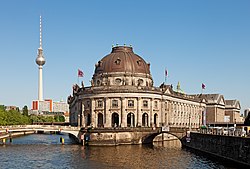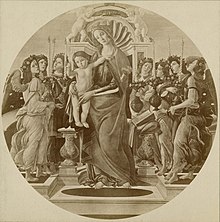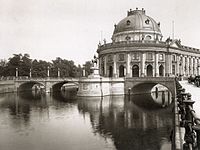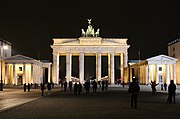art.wikisort.org - Museum
The Bode-Museum (English: Bode Museum), formerly called the Kaiser-Friedrich-Museum (Emperor Frederick Museum), is a listed building on the Museum Island in the historic centre of Berlin. It was built from 1898 to 1904 by order of German Emperor William II according to plans by Ernst von Ihne in Baroque Revival style. The building's front square featured a memorial to German Emperor Frederick III, which was destroyed by the East German authorities.[1] Currently, the Bode-Museum is home to the Skulpturensammlung, the Museum für Byzantinische Kunst and the Münzkabinett (sculpture, coins and medals, and Byzantine art).[2] As part of the Museum Island complex, the Bode-Museum was inscribed on the UNESCO World Heritage List in 1999 because of its outstanding architecture and testimony to the development of museums as a cultural phenomenon in the late 19th and early 20th centuries.[3]
 | |
 | |
Former name | Kaiser-Friedrich-Museum |
|---|---|
| Established | 1904 |
| Location | Museum Island, Berlin |
| Coordinates | 52°31′19″N 13°23′41″E |
| Type | Art museum |
| Website | Bode-Museum |
UNESCO World Heritage Site | |
| Part of | Museumsinsel (Museum Island), Berlin |
| Criteria | Cultural: ii, iv |
| Reference | 896 |
| Inscription | 1999 (23rd Session) |
| Area | 8.6 ha |
| Buffer zone | 22.5 ha |
History and collections
Originally called the Kaiser-Friedrich-Museum after Emperor Frederick III, the museum was renamed in honor of its first curator, Wilhelm von Bode, in 1956.[citation needed]
During World War II, portions of the collection were stored in an antiaircraft tower called the Flakturm Friedrichshain for safe keeping. In May 1945, several fires destroyed some of the collections. In total, more than 400 paintings and about 300 sculptures were missing due to looting during the fire or destroyed in the fire itself.[4]
Closed for repairs since 1997, the museum was reopened on 18 October 2006, after a €156 million refurbishment.[5] True to the ethos of its founding director, Wilhelm von Bode, who believed in mixing art collections,[6] it is now the home for a collection of sculptures, Byzantine art, and coins and medals.[7] The presentation of the collections is both geographic and chronological, with the Byzantine and Gothic art of northern and southern Europe displayed separately on the museum's first floor and a similar regional division of Renaissance and Baroque art on its second floor.[6]

The sculpture collection displays artwork of the Christian Orient (with an emphasis on Coptic Egypt), sculptures from Byzantium and Ravenna, sculptures of the Middle Ages, the Italian Gothic, and the early Renaissance, including the controversial Flora attributed by Bode to Leonardo da Vinci but now widely argued to be a 19th-century work. Late German Gothic works are also represented by Tilman Riemenschneider, the south German Renaissance, and Prussian Baroque art up to the 18th century. In the future selected works of the Gemäldegalerie will be integrated into the sculpture collection. This is reminiscent of William von Bode's concept of "style rooms", in which sculptures, paintings, and crafts are viewed together, as was usual in upper middle-class private collections.
The Münzkabinett ("coin cabinet") is one of the world's largest numismatic collections. Its range spans from the beginning of minting in the 7th century BC in Asia Minor up to the present day. With approximately 500,000 items, the collection is a unique archive for historical research, while its medal collection also makes it an important art exhibition.[citation needed]
Writing in The Financial Times on the occasion on the museum's reopening in 2006, Neil MacGregor, director of the British Museum, hailed “the most comprehensive display of European sculpture anywhere.” He added: “It is no exaggeration to say that in the new Bode Museum, Europe will be able for the first time to read its history — aesthetic and religious, intellectual and political — in a three-dimensional form.”[6]
Canadian gold coin theft

On 27 March 2017, a solid gold coin called the Big Maple Leaf, issued by the Royal Canadian Mint in 2007 as a commemorative piece, was stolen from the museum.[8][9] The coin, at 50 cm in diameter and 2.8 cm in thickness, is made of 24-karat gold and is worth around €3.7 million.[10] A ladder was found on the train tracks nearby, leading German police to speculate that the thief entered the building by breaking open a window in the back of the museum next to the railway tracks.[8][10]
The thieves were later found to be 21and 23-year-old cousins Ahmed and Wissam Remmo, along with their friend Denis W.[11] Police don't expect to ever recover the coin, as the presence of gold dust leads them to believe the culprits had melted it down. Amhed's brother Wayci was also charged, but later acquitted.
Pop culture
The museum appears as a playable level in the World War II video game Sniper Elite V2.[citation needed]
See also
- List of art museums
- List of museums in Germany
Gallery
- At night
- The entrance hall
- The cupola
- Byzantine collection
- Trecento room
- Museum Island with Pergamon Museum and Bode Museum (1951)
- Bode-Museum, Berlin von der Spree.
- View from the Bode Museum bridge on to the river

References
- Bodemuseum (Kaiser-Friedrich-Museum)(in German) Landesdenkmalamt Berlin Archived 18 July 2020 at the Wayback Machine
- Bode-Museum (in English) Staatliche Museen zu Berlin
- "Museumsinsel (Museum Island), Berlin". UNESCO World Heritage Centre. United Nations Educational Scientific and Cultural Organization. Retrieved 30 July 2022.
- "Beauty, Fire, & Memory: Lost Art of the Kaiser-Friedrich-Museum". National Gallery of Art Department of Image Collections. Archived from the original on 24 October 2020. Retrieved 19 November 2021.
- "Teuer, billig, im Plan: Berliner Kulturbauten und was sie kosten". Der Tagesspiegel. 17 October 2013.
- Alan Riding (27 November 2006), German Museums Move Closer to Reunification The New York Times.
- History – Sculpture Collection and Museum of Byzantine Art.
- "Solid gold coin worth $4m stolen from Berlin museum". BBC News. 27 March 2017. Retrieved 27 March 2017.
- Dowling, Tim (28 March 2017). "Forging pound coins? That's not a crime – it's a job". the Guardian. Retrieved 10 April 2022.
- Hall, Melanie (28 March 2017). "Giant gold coin worth almost €4 million stolen from Berlin museum in dawn heist". The Telegraph. Retrieved 27 March 2017.
- Dafoe, Taylor (21 February 2020). "The Bumbling Thieves Who Stole an Enormous $4.3 Million Gold Coin From a Berlin Museum—and Probably Melted It Down—Are Heading to Prison". Artnet News.
External links
- Official website
- Sculpture Collection and Museum of Byzantine Art
- Virtual Tour Through 35 Rooms (Sculpture Collection and Byzantine Art)
- Numismatic Collection
- Virtual Tour Through Numismatic Collection (with Gateway to Online Catalogue) Archived 6 September 2015 at the Wayback Machine
На других языках
[de] Bode-Museum
Das Bode-Museum im Berliner Ortsteil Mitte gehört zum Bauensemble der Museumsinsel und damit zum Weltkulturerbe der UNESCO. Im Auftrag Kaiser Wilhelms II. von 1898 bis 1904 von Ernst von Ihne im Stil des Neobarock als Kaiser-Friedrich-Museum erbaut, beheimatet es die Skulpturensammlung und das Museum für Byzantinische Kunst sowie das Münzkabinett.[1] Auf dem Vorplatz befand sich das von Rudolf Maison geschaffene Reiterstandbild Friedrichs III., das in der DDR-Zeit zerstört wurde.- [en] Bode Museum
[es] Museo Bode
El Museo Bode es un museo de arte —escultura, arte egipcio y bizantino y numismática— de Alemania que pertenece al grupo museístico de la Isla de los Museos de Berlín. El edificio que alberga el museo, terminado en 1904, fue diseñado por el arquitecto Ernst von Ihne y su estilo corresponde al neobarroco de fines del siglo XIX e inicios del siglo XX. Es un edificio protegido.[fr] Bode-Museum
Le Bode-Museum est un des musées de la ville de Berlin. Il se dresse à la pointe nord de l'île aux Musées, au bord de la Sprée, en plein centre de Berlin. À proximité du musée de Pergame. On y accède par le pont Monbijou (Monbijoubrücke en allemand). Au temps des deux Allemagnes, le Bode-Museum se trouvait, comme toute l'île aux Musées, en Allemagne de l'Est (RDA). Ses vastes salles rouvertes en 2006, à l'issue d'une longue restauration, offrent une splendide collection de sculptures, du Moyen Âge à l'époque classique.[ru] Музей Боде
Музей Боде (нем. Bode-Museum) — художественный музей в составе ансамбля Музейного острова в Берлине, в котором размещаются экспозиции Скульптурного собрания, Музея византийского искусства и Монетного кабинета. 17 октября 2006 года музей открылся после шестилетней реставрации. До 1945 года музей носил имя кайзера Фридриха. В 1956 году распоряжением министра культуры ГДР Иоганнеса Р. Бехера музей получил имя Вильгельма фон Боде.Другой контент может иметь иную лицензию. Перед использованием материалов сайта WikiSort.org внимательно изучите правила лицензирования конкретных элементов наполнения сайта.
WikiSort.org - проект по пересортировке и дополнению контента Википедии








